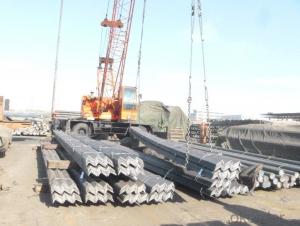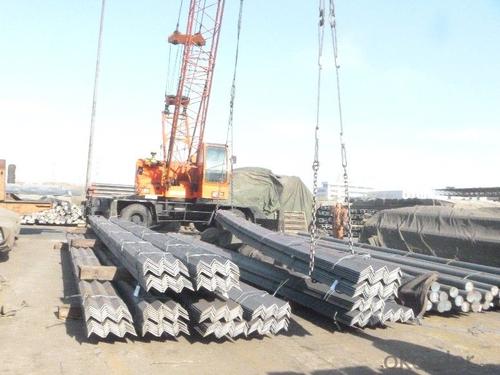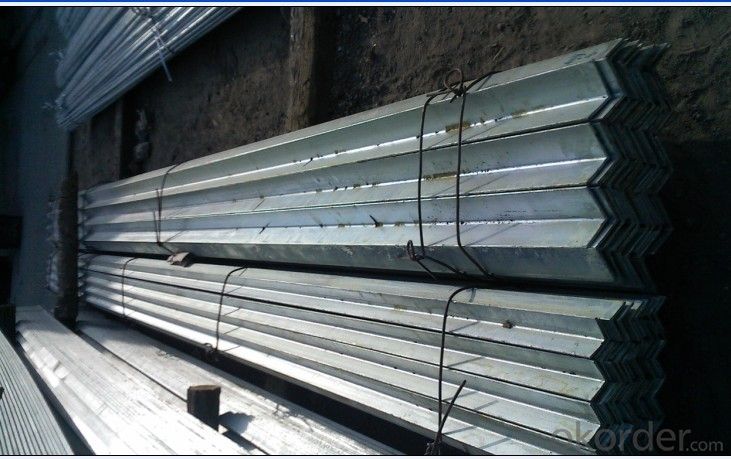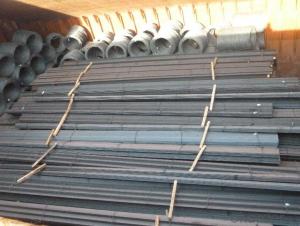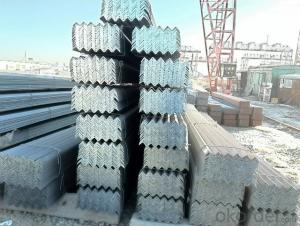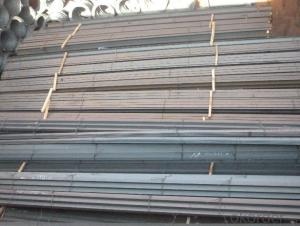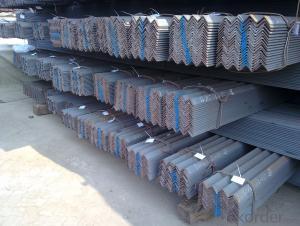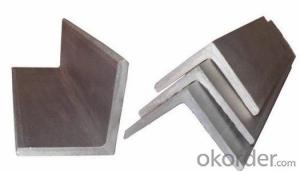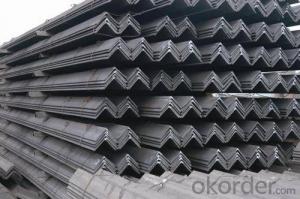angle bar
- Loading Port:
- China Main Port
- Payment Terms:
- TT OR LC
- Min Order Qty:
- -
- Supply Capability:
- -
OKorder Service Pledge
OKorder Financial Service
You Might Also Like
Product Description:
Specifications of Angle Steel
1. Invoicing on theoretical weight or actual weight as customer request
2. Length: 6m, 9m, 12m as following table
3. Sizes
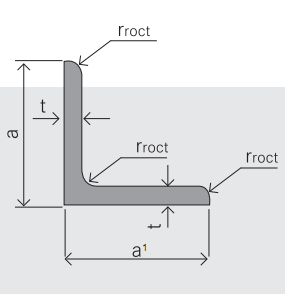
Sizes: 25mm-250mm | ||
a*t | ||
25*2.5-4.0 | 70*6.0-9.0 | 130*9.0-15 |
30*2.5-6.6 | 75*6.0-9.0 | 140*10-14 |
36*3.0-5.0 | 80*5.0-10 | 150*10-20 |
38*2.3-6.0 | 90*7.0-10 | 160*10-16 |
40*3.0-5.0 | 100*6.0-12 | 175*12-15 |
45*4.0-6.0 | 110*8.0-10 | 180*12-18 |
50*4.0-6.0 | 120*6.0-15 | 200*14-25 |
60*4.0-8.0 | 125*8.0-14 | 250*25 |
5. Payment terms:
1).100% irrevocable L/C at sight.
2).30% T/T prepaid and the balance against the copy of B/L.
3).30% T/T prepaid and the balance against L/C
6.Material details:
Alloy No | Grade | Element (%) | | ||||
C | Mn | S | P | Si | | ||
| | |||||||
|
|
|
|
|
|
| |
Q235 | B | 0.12—0.20 | 0.3—0.7 | ≤0.045 | ≤0.045 | ≤0.3 | |
|
|
|
|
|
|
| |
Alloy No | Grade | Yielding strength point( Mpa) | | ||||
Thickness (mm) | | ||||||
≤16 | >16--40 | >40--60 | >60--100 | | |||
≥ | | ||||||
|
|
|
|
|
| | |
Q235 | B | 235 | 225 | 215 | 205 | | |
Alloy No | Grade | Tensile strength (Mpa) | Elongation after fracture (%) | | |||
Thickness (mm) | | ||||||
| ≤16 | >16--40 | >40--60 | >60--100 | | ||
≥ | | ||||||
|
|
|
|
|
|
| |
Q235 | B | 375--500 | 26 | 25 | 24 | 23 | |
Usage & Applications of Angle Steel
According to the needs of different structures, Angle can compose to different force support component, and also can be the connections between components. It is widely used in various building structures and engineering structures such as roof beams, bridges, transmission towers, hoisting machinery and transport machinery, ships, industrial furnaces, reaction tower, container frame and warehouse etc.
Packaging & Delivery of Angle Steel
1. Packing: it is nude packed in bundles by steel wire rod
2. Bundle weight: not more than 3.5MT for bulk vessel; less than 3 MT for container load
3. Marks:
Color marking: There will be color marking on both end of the bundle for the cargo delivered by bulk vessel. That makes it easily to distinguish at the destination port.
Tag mark: there will be tag mark tied up on the bundles. The information usually including supplier logo and name, product name, made in China, shipping marks and other information request by the customer.
If loading by container the marking is not needed, but we will prepare it as customer request.
Production flow of Angle Steel
Material prepare (billet) —heat up—rough rolling—precision rolling—cooling—packing—storage and transportation
- Q: How do steel angles perform in terms of vibration resistance?
- Due to their robust and inflexible structure, steel angles generally exhibit excellent vibration resistance. The L-shaped configuration of a steel angle not only enhances its strength and stability but also grants it heightened resistance to vibrations. When utilized in construction or engineering endeavors, steel angles effectively absorb and mitigate vibrations, thereby minimizing the potential for structural damage or failure. The rigidity and notable tensile strength of steel angles enable them to withstand dynamic loads and vibrations stemming from diverse factors, such as wind, earthquakes, or machinery operations. They proficiently distribute and dissipate vibrational forces throughout their structure, averting excessive movement or oscillation. This proves particularly pivotal in applications requiring steadfastness and longevity, such as in the construction of bridges, buildings, or industrial equipment. Furthermore, steel angles can be tailored and fabricated to meet precise vibration resistance specifications. By selecting suitable steel grades and dimensions, engineers can optimize the performance of steel angles in terms of vibration resistance. They also possess the ability to incorporate supplementary characteristics like stiffeners or reinforcements, further augmenting the vibration resistance of steel angle structures. Collectively, steel angles have demonstrated their dependability and effectiveness in withstanding vibrations, rendering them a favored choice across a multitude of industries and applications where upholding structural integrity is of paramount importance.
- Q: Can steel angles be used in the construction of warehouses?
- Indeed, warehouses can utilize steel angles for their construction. Owing to their robustness and endurance, steel angles are frequently employed as structural elements in buildings and warehouses. They offer stability and bolster the entire structure, rendering them appropriate for diverse construction purposes. In the realm of warehouse construction, steel angles serve as framing components, columns, beams, and supports, contributing to the establishment of a sturdy and dependable edifice. Furthermore, steel angles exhibit adaptability and can be readily tailored and manufactured to satisfy precise design specifications, thus establishing their prominence as a favored option in warehouse construction ventures.
- Q: Can steel angles be used as supports for HVAC systems or ductwork?
- Yes, steel angles can be used as supports for HVAC systems or ductwork. Steel angles are commonly used in construction and engineering projects due to their strength and durability. They can provide a stable and secure support structure for HVAC systems or ductwork, ensuring that they are properly installed and can withstand the weight and vibrations associated with their operation. Steel angles can be easily fabricated and installed, making them a cost-effective and efficient solution for supporting HVAC systems or ductwork.
- Q: What are the different types of steel angles used in storage tank construction?
- There are several types of steel angles used in storage tank construction, including L-shaped angles, T-shaped angles, and unequal angles. L-shaped angles are commonly used for the tank shell and roof support, while T-shaped angles are often used for the tank bottom and annular ring. Unequal angles are used for reinforcing various sections of the tank structure.
- Q: Can steel angles be used in railway or transportation infrastructure?
- Yes, steel angles can be used in railway or transportation infrastructure. They are commonly used for various structural applications such as support beams, bridge construction, and track alignment. Steel angles provide stability, strength, and durability, making them suitable for heavy-duty and high-load environments in railway and transportation infrastructure.
- Q: Can steel angles be used for framing windows or doors?
- Yes, steel angles can be used for framing windows or doors. Steel angles are commonly used in construction for their strength and durability. They provide structural support and stability when used as framing material. Steel angles can be easily customized and cut to the desired length, making them suitable for framing windows and doors of various sizes. Additionally, steel angles can be welded or bolted together to create a sturdy frame that can withstand heavy loads and provide the necessary support for windows and doors.
- Q: What is the typical corrosion resistance of steel angles?
- The typical corrosion resistance of steel angles depends on the specific type of steel and the environmental conditions it is exposed to. However, steel angles are commonly coated with materials such as zinc, epoxy, or paint to enhance their resistance to corrosion. In general, steel angles have good corrosion resistance, but their durability can be further improved by using appropriate coatings and regular maintenance.
- Q: Can steel angles be used for agricultural buildings or barns?
- Yes, steel angles can be used for agricultural buildings or barns. Steel angles are commonly used in construction due to their strength and durability. They are particularly useful in agricultural buildings or barns where the structure needs to withstand heavy loads and harsh weather conditions. Steel angles can be used for framing, bracing, and reinforcing various components of the building, such as walls, roofs, and doors. Additionally, steel angles can be easily fabricated and customized to meet specific design requirements, making them a versatile choice for agricultural buildings or barns.
- Q: Can steel angles be used for reinforcement bars?
- Steel angles cannot be used as reinforcement bars. Despite being made of steel, they possess different structural properties and serve different purposes. Reinforcement bars, or rebar, are specially designed to enhance the tensile strength and reinforcement of concrete structures. They have a ribbed or deformed surface that facilitates better bonding with the concrete. Conversely, steel angles are L-shaped structural components primarily employed for support and stability in construction endeavors. They are unsuitable for providing the necessary tensile strength and bonding required for concrete reinforcement. Hence, it is imperative to use the appropriate materials for their intended purposes to ensure the construction project's structural integrity and safety.
- Q: Can steel angles be used for pipe supports?
- Yes, steel angles can be used for pipe supports. Steel angles provide a strong and durable option for supporting pipes due to their structural integrity and load-bearing capabilities. The L-shaped design of steel angles offers excellent stability and can be easily mounted to walls, ceilings, or other structural elements. Additionally, steel angles can be welded or bolted together to create custom configurations that suit specific pipe support requirements. Their versatility, strength, and ease of installation make steel angles a popular choice for pipe support applications in various industries such as construction, plumbing, and manufacturing.
Send your message to us
angle bar
- Loading Port:
- China Main Port
- Payment Terms:
- TT OR LC
- Min Order Qty:
- -
- Supply Capability:
- -
OKorder Service Pledge
OKorder Financial Service
Similar products
Hot products
Hot Searches
Related keywords
